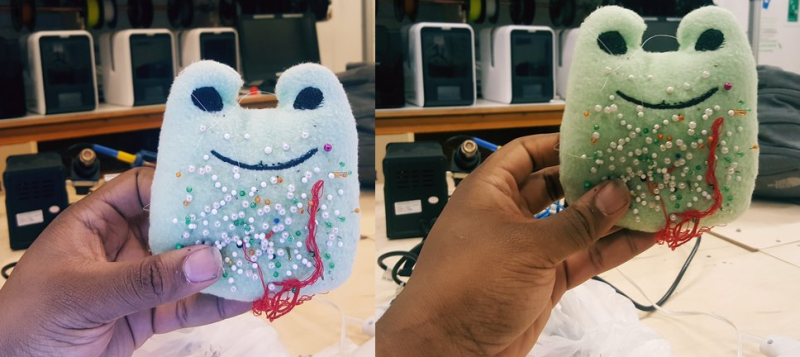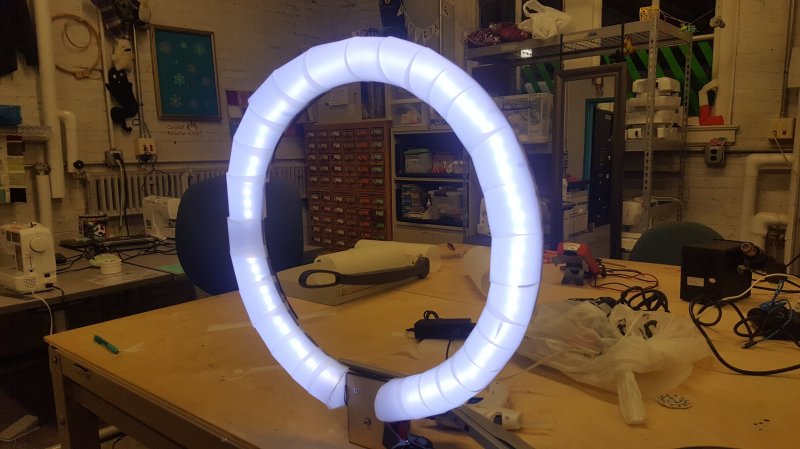[Brandon Rice] is at it again — this time to level-up your photography and video production skills with a diffused light ring.
Inspired into creating more video content, he wanted to forgo the price tag associated with consumer lighting rigs. A 19″ diameter ring fit his requirements, but since the only laser cutter he had access to was limited to 12″x14″, he was forced to assemble it in pieces. As he screwed it together, he hid the M6 screws by pointing them ‘forwards,’ to be hidden underneath the diffusing vellum material. Liberal application of hot glue has kept the arched vellum and the LED strips in place with only a nominal number of burned fingers.
 [Rice] adds that the electronics were probably the easiest part of the project, involving a battery switch and a simple lamp circuit, hiding it behind another slice of laser-cut wood. A quick flick of the switch, and he’s in director mode.
[Rice] adds that the electronics were probably the easiest part of the project, involving a battery switch and a simple lamp circuit, hiding it behind another slice of laser-cut wood. A quick flick of the switch, and he’s in director mode.
Outside of videography, there are plenty of precision applications for light rings, from light right where you need it most during your next build, to a more mobile application of a lighting setup.















That is a huge difference in that photo. A great improvement regarding lighting of the subject. Though If you make aclosup of a face it will immediately show that ring-lighting is used as the eyes turn scary due to the white ring reflectiong in the eyes. But other then that it is a great way to light a subject.
If you really want to go low-cost, use a semi-transparant storage box put that close to a window/lightsource and you’d get a really soft and natural light (don’t use your camera flash).
Huh?!?!? : “As he screwed it together, he hid the M6 screws by pointing them ‘forwards,’”
He must have used double-action M6 screws there, the M6 screws I have here can only point backwards (whatever that means).
Which photo is “before” and which is “after”? The blue color of the light on the left photo seems to match the led ring, but that photo looks worse IMO.
hmmm… you have a point. I just assumed it was the right (because it is always before(left) after (right).
The left one indeed looks worse, oops…
Indeed, the bluish tint and poor CRI of LED ring lights is a little no-no. I hate to mention them, but T9 22W circular CFL lamps can still outperform cheap LED strips in CRI area, while emitting a ton of light. Various color temps are available.
Yeah, generic white leds suck for photography.
If you just want even lighting, rather than the glamour ring-flash look, turning your flash backwards to bounce off the room usually works.
A real flash is much higher output than an LED strip light, and is a known – and usually better – colour temperature.
A cheap ring-flash for stills is easily built using a couple of metal dishes – cut the bottoms out and nest them to make a doughnut, cut a hole in the bottom for a flash to go in, and cover the open side with velum/etc. It’ll be a little hotter near the flash, but you can layer velum to counter this.
For video though, if you’re not worried about colour temperature or there’s no other light sources so you can balance for it, this approach is effective.
Not convinced…. Over exposed blueish low CRI…. Warm White LED’s should have been a better choice…
You can get a commercial led ring light for $60. https://www.adorama.com/fprlled19.html?gclid=Cj0KCQjwkd3VBRDzARIsAAdGzMCdD1Gnl2qx1y5I_JHgbqI6KLyWi2FQvt5_s_F_BEG5tF1c61Vqz0EaAoHDEALw_wcB
Cheaper than time and materials to build one and it might have better leds in it.
might have better leds in it.
Don’t bet on it. I have a rectangular version from the same manufacturer and vendor. It’s crap, despite having both warm white (“2700 K”) and daylight (“5000 K”) LEDs in it. Maybe OK for simple video demos, but crap for good technical videos, and even worse for skin tones.
Oh well, I have big monolights for studio stuff, LEDs just rarely look good.
Just take a old lcd display and remove the display and cut a hole in it for your lens.